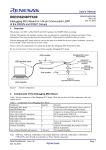Download RTE-V850E/MA1-IE Hardware User`s Manual
Transcript
RTE-V850E/MA1-IE Hardware User's Manual RealTimeEvaluator RTE-V850E/MA1-IE Hardware User's Manual REVISION HISTORY Rev. 1.0 December 3, 1999 1st edition Rev. 1.1 October 20, 2000 Clerical error correction Tron command, … 1 RTE-V850E/MA1-IE Hardware User's Manual CONTENTS 1. INTRODUCTION .............................................................................................................. 3 2. MAIN FEATURES............................................................................................................ 4 3. HARDWARE SPECIFICATION.......................................................................................... 5 4. SYSTEM CONFIGURATION ............................................................................................. 6 5. INSTALLATION................................................................................................................ 7 6. SETTING THE DIP SWITCH ............................................................................................. 8 7. DISPLAY LED................................................................................................................. 8 8. CONNECTING WITH THE USER SYSTEM ........................................................................ 9 Switching power on............................................................................................................................................... 9 Switching power off............................................................................................................................................... 9 9. PRECAUTIONS ............................................................................................................. 10 Precautions for connecting the user system .................................................................................................10 Handling the RTE-V850E/MA1-IE.....................................................................................................................10 Confirming connection with the host system .................................................................................................10 External clock input.............................................................................................................................................10 Cautions related to delay time..........................................................................................................................10 HALT instruction ..................................................................................................................................................11 ROM space in emulation memory ...................................................................................................................11 Breakpoint and break address .........................................................................................................................11 Time tag for trace.................................................................................................................................................11 Trigger setting......................................................................................................................................................11 Break operation on two instructions executed simultaneously..................................................................11 NQPACK set consumables ...............................................................................................................................12 2 RTE-V850E/MA1-IE Hardware User's Manual 1. INTRODUCTION The RealTimeEvaluator-V850E/MA1-IE (hereafter called the RTE-V850E/MA1-IE) is an in-circuit emulator for the NEC RISC microcomputer V850E/MA1. Using a dedicated emulator chip in the RTE-V850E/MA1-IE has made it highly transparent, compact, and lightweight. The RTE-V850E/MA1-IE is supported by two debug monitors, GHS's Multi and Midas's PARTNER. Users can select either debug monitor according to the operating environment of their system. The host system for the RTE-V850E/MA1-IE must be the PC98 series or DOS/V machine that has the environment in which either of the debug monitors mentioned above can run. The host system and the RTE-V850E/MA1-IE are connected via the interface card for a dedicated PCMCIA card or for the desktop machine. The RTE-V850E/MA1-IE is supposed to come with the following items. Make sure that you received all these items. 1. RTE-V850E/MA1-IE main unit : One each 2. RTE for Win32 setup disk : One each 3. User's manual : One each 4. Grounding clip : One each 5. RTE-PS03 power supply unit : One each 6. NQPACK set : One each In addition to the above items, the following are required in using the RTE-V850E/MA1-IE. They are not standard accessories. 7. Interface kit (interface card and cable set) selected from: • PC card interface kit • PC98 desktop PC interface kit • DOS/V desktop PC interface kit • PCI bus interface kit 8. Debugger selected from: • GHS C + Multi + Midas server • PARTNER 3 RTE-V850E/MA1-IE Hardware User's Manual 2. MAIN FEATURES One of two source-level debuggers can be selected. Users can select either high-level language debugger, Multi of Green Hills Software (GHS) or PARTNER of Midas. GHS's Multi supports seamless debugging in an C/C++ integrated environment. Meanwhile, PARTNER supports the C language of both GHS and NEC (CA850), allowing users to set up the tool environment as they like. Both debuggers are provided with sufficient functions as a high-level language debugger. Simply clicking the mouse on the source enables running programs, setting break points, and inspecting variables. Highly transparent emulation functions are provided. Use of a dedicated emulation chip in the RTE-V850E/MA1-IE enables controlling emulation without using functions in the V850E/MA1. Almost all signal lines can be connected directly to the chip. As a result, the emulation functions are provided with both functionally and electrically high transparency. The standard configuration provides a sufficient emulation memory capacity. The standard memory configuration of the V850E/MA1-IE matches the ROM and RAM internal to the V850E/MA1, and the 4 Mbytes of emulation memory external to the V850E/MA1. A realtime trace function is provided. The RTE-V850E/MA1-IE has a realtime trace function useful in debugging a built-in system. The realtime trace function can trace 32K cycles of any types including internal memory access cycles, as driven by events. A dedicated communication card is available for communication with the host. Four different communication cards and a LAN interface are available. For machines that have card slots, the Type-2 PC card that conforms to the PCMCIA Ver2.1/JEIDA Ver4.2 standard is used. For desktop machines, the C bus card is used in the PC98 series, while the ISA or PCI bus card is used in PC-AT compatible machines. When connecting to the host through a LAN, use the LAN-BOX. 4 RTE-V850E/MA1-IE Hardware User's Manual 3. HARDWARE SPECIFICATION Emulation section Target device Emulation function Clock frequency Clock source (main clock) Internal ROM emulation capacity Internal RAM emulation capacity External memory emulation capacity External memory mapping unit Memory mapping type Break function Event setting Step break Manual break Fail-safe break Write protection Guard area Trace function Event setting 1. 50 MHz Automatic switching between external and internal clocks (internal: 50 MHz) 512 KB (max) 60 KB (max) 4 MB 1 MB RAM, ROM, GUARD, USER Execution address condition : 4 points Access cycle condition : 4 points Available Available Available Available Trace memory Trace delay Time measurement function Measurement start Measurement stop Resolution Maximum measurement time Number of functions Internal RAM realtime display Pin mask function Bus timeout function Voltage operating range Remarks V850E/MA1 (LQFP-144) Execution address condition : 2 points Access cycle condition : 3 points 166 bits x 32K words 0-7FFFh At the beginning of execution Till the occurrence of a break 1 CPU clock cycle 232 CPU clock cycles 1 ch 1 KB RESET-, NMI, WAIT-, HLDRQAvailable 3.3 V For external emulation memory, two wait cycles are forcibly inserted. 2. External emulation memory cannot be used with an 8 -bit bus. Host and interface sections Item Target host machine Debug monitor Interface Power supply Description PC-98 series DOS/V machine Green Hills : Multi (Windows95) Midas : PARTNER (Windows95, 98, NT) PC card Type-2 (PCMCIA Ver2.1/JEIDA Ver4.2 or higher), C bus, ISA bus, PCI bus, and LAN-BOX Dedicated AC adapter: RTE-PS03 (input = 100 V and output = +5 V, 3.5 A) 5 RTE-V850E/MA1-IE Hardware User's Manual 4. SYSTEM CONFIGURATION The system configuration of this product is shown below. PC98 interface card PC98 series Power supply PARTNER/Win PC-AT or compatible PC-AT interface card (ISA and PCI) RTE-xxxx-IE main unit GHS Multi NQ pack set PC interface card HRS Note PC Cable (accompanying the interface card) Remark Each PC system must be able to offer an environment in which the debugger to be used can operate. 6 RTE-V850E/MA1-IE Hardware User's Manual 5. INSTALLATION The product is installed according to the following procedure. 1. Installing the interface card → Refer to the applicable manual for the interface card to be used. 2. Installing RTE for Win32 3. Initializing RTE for Win32 → Refer to the applicable manual for RTE for Win32. (1) Start chkrte2.exe, and initialize the following parameters. RTE : V850E/MA1-IE I/F-1 : <<Specify the interface card you want to use. I/F-2 : <<Specify an IO port as required. → Refer to the applicable manual for RTE for Win32 for details. 4. Installing the debug monitor → Refer to the applicable manual for the target monitor. 5. Connecting with the user system → See Section 8 in this manual. The setup of this system (exemplifying use of the PC card) is shown below. Dedicated AC adapter RTE-V850E/MA1-IE main unit SW2 SW1 PC card interface User interface section Grounding clip 7 RTE-V850E/MA1-IE Hardware User's Manual 6. SETTING THE DIP SWITCH A switch at the front of the RTE-V850E/MA1-IE is used to specify the emulation mode. SW1 should be set according to the configuration of the user system. SW1 is an eight-contact switch while SW2 is a four-contact switch. All contacts of SW2 should be set to OFF. SW1 Symbol 1 MODE0 2 MODE1 3 MODE2 Function Initial value Used to specify the CPU default mode ON [MODE2, MODE1, MODE0] OFF Romless mode0 : [ ON , ON , ON ] ON Romless mode1 : [ ON , ON , OFF ] Single mode0 : [ ON , OFF , ON ] Single mode1 : [ ON , OFF , OFF ] 4 Factory use Always ON ON 5 Factory use Always ON ON 6 Factory use Always ON ON 7 CKSEL Used to specify the CPU clock operation mode ON ON: PLL mode, OFF: Direct mode 8 CLKINT Used to switch the clock supplied to the CPU OFF ON: Internal clock, OFF: Auto select [MODE2, MODE1, MODE0] Specify the CPU mode used when the debugger starts with the user system not connected. When a target is connected, the mode specified by the target mode pin is used. [CKSEL] Specifies the clock operation mode used when the user system is not connected. When a target is connected, the mode specified by the target CKSEL pin is used. [CLKINT] Switches the clock supplied to the CPU. OFF : When the user system is connected, the system clock is supplied. Otherwise, the internal clock is used. ON : The internal clock is always used. (The internal clock frequency is 5 MHz.) [Factory use] This contact should be always set to ON. 7. DISPLAY LED The following LEDs are on the side of the main unit. POWER : Lights when the RTE system power is on. USER : Lights when power is supplied to the user system. RUN : Lights when a user program is running. 8 RTE-V850E/MA1-IE Hardware User's Manual 8. CONNECTING WITH THE USER SYSTEM Connect the RTE-V850E/MA1-IE with a personal computer while referring to the applicable manual for the interface kit used between them. To connect the RTE to the user system, first install its accompanying NQPACK in the user system while referring to the NQPACK technical document, then connect the RTE-V850E/MA1-IE. [Caution] Before connecting the CPU section, attach a grounding clip leading to the RTE-V850E/MA1-IE main unit to a signal ground of the user system. Switching power on 1. Switch on power to the host personal computer. 2. Connect a power supply dedicated to the RTE to the power supply jack of the RTE-V850E/MA1-IE. 3. Switch on power to the user system. 4. Start the debug monitor. Switching power off 1. Exit the debug monitor. 2. Switch off power for the user system. 3. Remove the power cord from the RTE-V850E/MA1-IE power supply jack. 4. Switch off power for the host personal computer. [Caution] When connecting the RTE-V850E/MA1-IE to the user system, take care about pin 1. If the connection is incorrect, all connected devices may get damaged. The following figure shows how the RTE-V850E/MA1-IE is connected to the user system. For details of the NQPACK, refer to its accompanying technical document. 1 pin V850E/MA1 Tip of the RTE-V850E/MA1-IE Type-F YQ socket YQ pack guide screw To a ground YQ pack Solder NQ pack User system 9 RTE-V850E/MA1-IE Hardware User's Manual 9. PRECAUTIONS This section summarizes the precautions you should observe when using the RTE-V850E/MA1-IE. Precautions for connecting the user system 1) The RTE system cannot operate with the user system turned off. Leaving it in this state may damage the user system. 2) After the user system power is switched off, if you want to continue using the RTE system, basically restart it from scratch. Otherwise, the RTE system may hang up. 3) If the CPU in the user system fails to operate normally (because, for example, a reset is active or the wait line is at a wait level), the RTE system may also fail to start up or may hang up with specific commands. Handling the RTE-V850E/MA1-IE 1) Do not allow the exposed socket pins at the bottom of the RTE tip come into contact metals when they are energized. Doing so may damage the unit. 2) Do not fold the flexible board of the RTE tip or bend it through more than 90°. Doing so may break a wire. Confirming connection with the host system Immediately after installation, run chkrte2.exe to select and set up the host interface card and RTE system, then perform connection tests. Refer to the RTE for Win32 Installation Manual for details. External clock input When using an external clock, note the following. * When supplying the clock from an oscillator, the frequency must be 30 MHz or less. * When connecting a crystal or other resonator, the frequency range must be 2 to 12 MHz. The constant of the external capacitor must be adjusted according to the resonator. Cautions related to delay time Almost all signals are connected directly between the CPU in the RTE and the user system (see Appendix B). However, a delay of about 3 ns (typical) may occur due to the wiring length required in getting to the tip and the capacity, compared with direct CPU connection. The user system must be designed so as to accommodate this delay. 10 RTE-V850E/MA1-IE Hardware User's Manual HALT instruction When program execution is broken with the HALT instruction, the address at the time matches the starting address of the next instruction after the HALT instruction. In addition, the HALT instruction should not be executed in single-step mode. ROM space in emulation memory When data is written to the space specified for ROM, a fail-safe break operation is performed but the contents of memory will be lost. Breakpoint and break address When program execution is broken, if a break point is set to two less than the break address, the actual PC value after breaking is reduced by two. Note the following. * Breakpoints should not be set for consecutive instructions. * Breakpoints should not be set immediately before the HALT instruction or branch instructions that branch to themselves. Time tag for trace A time tag cannot be used with the first instruction immediately after a starting position. It also cannot be used during single-step execution. Trigger setting The address of the first instruction immediately after a starting position cannot be specified as a trigger point. Break operation on two instructions executed simultaneously * Single-step execution is broken after the two instructions are executed. * If a break point is set in the ROM area for the latter instruction of the two that are executed simultaneously, the program execution is broken at the next instruction. * If a break points is set for the latter instruction of the two that are executed simultaneously and program execution is started at the former instruction, the execution is not broken. 11 RTE-V850E/MA1-IE Hardware User's Manual NQPACK set consumables (1) 144-pin type-F YQ socket YQS-144SDF (2) 144-pin YQ pack YQP-144SD with guide screws (3) 144-pin NQ pack NQP-144SD [Remark] The sockets shown above are consumables. They should be replaced regularly, for example after about 50 cycles of insertion/removal. However, a soldered socket at the lower surface of the RTE-V850E/MA1-IE cannot be replaced. If it is expected that it is subjected to frequent insertion/removal, install a 144-pin YQ socket previously for protection purposes. 12 RTE-V850E/MA1-IE Hardware User's Manual - Memo - RTE-V850E/MA1-IE Hardware User's Manual M921MNL02 13































